TimTaiLieu.vn - Tài liệu, ebook, giáo trình, đồ án, luận văn
Tổng hợp tất cả tài liệu, ebook, giáo trình Kế Toán - Kiểm Toán chọn lọc và hay nhất.

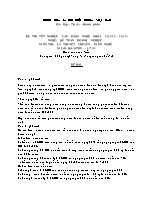 Đề và đáp án thi tốt nghiệp cao đẳng nghề khóa 5 - Nghề: Kế toán doanh nghiệp - Mã đề thi: KTDN - LT 02
Đề và đáp án thi tốt nghiệp cao đẳng nghề khóa 5 - Nghề: Kế toán doanh nghiệp - Mã đề thi: KTDN - LT 02ĐỀ BÀI Câu 1: ( 2 điểm) Trình bày khái niệm và giải thích công thức tính lãi đơn, lãi kép? Tính bài tập sau: Vào ngày 1/1, một công ty TNHH mua một ngôi nhà làm văn phòng giao dịch với giá 200 triệu đồng với sự thỏa thuận thanh toán như sau: - Trả ngay 10% số tiền - Số còn lại trả dần hàng năm bằng nhau trong 5 năm song phải chịu lãi 6% một năm...
 2 trang | Chia sẻ: nguyenlinh90 | Ngày: 19/07/2019 | Lượt xem: 647 | Lượt tải: 2
2 trang | Chia sẻ: nguyenlinh90 | Ngày: 19/07/2019 | Lượt xem: 647 | Lượt tải: 2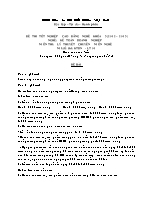 Đề và đáp án thi tốt nghiệp cao đẳng nghề khóa 5 - Nghề: Kế toán doanh nghiệp - Mã đề thi: KTDN - LT 01
Đề và đáp án thi tốt nghiệp cao đẳng nghề khóa 5 - Nghề: Kế toán doanh nghiệp - Mã đề thi: KTDN - LT 01ĐỀ BÀI Câu 1: (2 điểm) Trình bày nội dung và phương pháp tính thuế giá trị gia tăng. Câu 2: (5 điểm) Có tài liệu của doanh nghiệp sản xuất Hoàng Anh như sau: I. Tài liệu năm báo cáo: 1. Số dư vốn lưu động bình quân trong 3 quí như sau: Quí 1: 1200 triệu đồng Quí 2: 1310 triêụ đồng Quí 3: 1350 triệu đồng 2. Doanh thu tiêu thụ sản phẩm ở 3 qu...
 3 trang | Chia sẻ: nguyenlinh90 | Ngày: 19/07/2019 | Lượt xem: 839 | Lượt tải: 2
3 trang | Chia sẻ: nguyenlinh90 | Ngày: 19/07/2019 | Lượt xem: 839 | Lượt tải: 2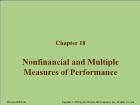 Chapter 18: Nonfinancial and Multiple Measures of Performance
Chapter 18: Nonfinancial and Multiple Measures of PerformanceFinancial measures can be easily quantified and can motivate employees to improve the company’s accounting profits. Also, shareholders and the business press often focus on financial measures. Therefore, financial measures get the attention of managers. Unfortunately, financial measures are often neither useful in identifying the cause of operati...
 17 trang | Chia sẻ: nguyenlinh90 | Ngày: 19/07/2019 | Lượt xem: 677 | Lượt tải: 1
17 trang | Chia sẻ: nguyenlinh90 | Ngày: 19/07/2019 | Lượt xem: 677 | Lượt tải: 1 Chapter 17: Additional Topics in Variance Analysis
Chapter 17: Additional Topics in Variance AnalysisIn this chapter, we discuss additional variances to illustrate some of the ways the basic variance analysis model can be extended and adapted to specific circumstances. The basic principles are exactly the same as those we discussed in Chapter 16.
 17 trang | Chia sẻ: nguyenlinh90 | Ngày: 19/07/2019 | Lượt xem: 848 | Lượt tải: 1
17 trang | Chia sẻ: nguyenlinh90 | Ngày: 19/07/2019 | Lượt xem: 848 | Lượt tải: 1 Chapter 16: Fundamentals of Variance Analysis
Chapter 16: Fundamentals of Variance AnalysisIn Chapter 13 we discussed the development of the master budget as a first step in the budgetary planning and control cycle. The budgeting process provides a means to coordinate activities among units of the organization, to communicate the organization’s goals to individual units, and to ensure adequate resources are available to carry out planned...
 17 trang | Chia sẻ: nguyenlinh90 | Ngày: 19/07/2019 | Lượt xem: 682 | Lượt tải: 1
17 trang | Chia sẻ: nguyenlinh90 | Ngày: 19/07/2019 | Lượt xem: 682 | Lượt tải: 1 Chapter 15: Transfer Pricing
Chapter 15: Transfer PricingWe saw in Chapter 12 that a decentralized firm delegates decision-making authority to subordinates. With this delegation of authority comes the risk of managers making decisions based on their individual goals that can be sub-optimal for the organization as a whole. One example of dysfunctional decision-making occurs when business units or division...
 17 trang | Chia sẻ: nguyenlinh90 | Ngày: 19/07/2019 | Lượt xem: 846 | Lượt tải: 1
17 trang | Chia sẻ: nguyenlinh90 | Ngày: 19/07/2019 | Lượt xem: 846 | Lượt tải: 1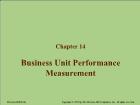 Chapter 14: Business Unit Performance Measurement
Chapter 14: Business Unit Performance MeasurementWe described the organization of the firm in Chapter 12 by referring to responsibility centers: cost centers, profit centers, and investment centers. In this chapter, we develop and analyze performance measures for investment centers. Recall that in an investment center, managers have responsibility for asset deployment in addition to revenue and c...
 17 trang | Chia sẻ: nguyenlinh90 | Ngày: 19/07/2019 | Lượt xem: 732 | Lượt tải: 1
17 trang | Chia sẻ: nguyenlinh90 | Ngày: 19/07/2019 | Lượt xem: 732 | Lượt tải: 1 Chapter 13: Planning and Budgeting
Chapter 13: Planning and BudgetingA budget is a financial plan of the resources needed to carry out activities and meet financial goals. The budget ties together the goals of the organization, the plans for achieving those goals, the decisions that are made, and finally, the performance evaluation. By identifying a company’s critical success factors, those strengths that enable t...
 17 trang | Chia sẻ: nguyenlinh90 | Ngày: 19/07/2019 | Lượt xem: 827 | Lượt tải: 0
17 trang | Chia sẻ: nguyenlinh90 | Ngày: 19/07/2019 | Lượt xem: 827 | Lượt tải: 0 Chapter 12: Fundamentals of Management Control Systems
Chapter 12: Fundamentals of Management Control SystemsIn the previous chapters we considered how information could be developed to help managers make decisions. In this chapter we will discuss the fundamentals of management control systems.
 17 trang | Chia sẻ: nguyenlinh90 | Ngày: 19/07/2019 | Lượt xem: 636 | Lượt tải: 1
17 trang | Chia sẻ: nguyenlinh90 | Ngày: 19/07/2019 | Lượt xem: 636 | Lượt tải: 1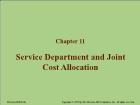 Chapter 11: Service Department and Joint Cost Allocation
Chapter 11: Service Department and Joint Cost AllocationWe have seen how cost allocation is used to develop the costs of products, services, and customers. However, part of the indirect cost incurred is from departments that do not directly produce the product or service but rather provide service to the departments that do produce the product or provide the service. In this chapter we will allocate the...
 17 trang | Chia sẻ: nguyenlinh90 | Ngày: 19/07/2019 | Lượt xem: 665 | Lượt tải: 1
17 trang | Chia sẻ: nguyenlinh90 | Ngày: 19/07/2019 | Lượt xem: 665 | Lượt tải: 1
Website đang trong thời gian thử nghiệm, chờ xin giấy phép của Bộ TT & TT.

